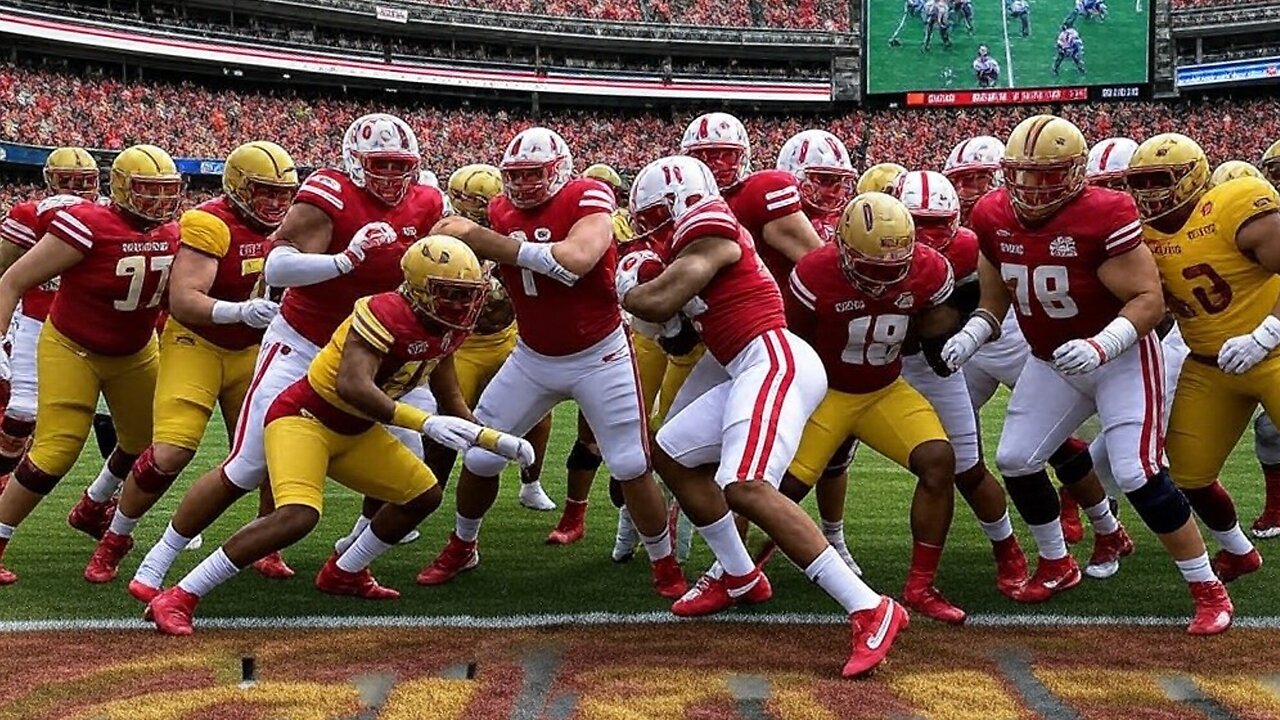Premium Only Content

Nebraska vs Boston College Matchup at Pinstripe Bowl with Quarterback Duel Between Raiola and James
Nebraska Huskers vs. Boston College Eagles: A Statistical Comparison
As the calendar flips to December 28, 2024, the Nebraska Huskers and Boston College Eagles are set to inscribe a new chapter in their football legacies at Yankee Stadium for the Pinstripe Bowl. This isn't just about two teams meeting for the first time; it's a deep dive into numbers, where every yard, every play, and every statistic weaves a narrative of strategy and opportunity.
Offensive Narratives:
Nebraska's offense, averaging 358.7 yards per game, has shown a preference for the ground game, churning out 150.2 rushing yards with an average of 3.8 yards per carry. This places them 96th in college football for efficiency, suggesting a struggle to break big plays. On the other hand, Boston College has been more effective, with 176.0 rushing yards per game, averaging 4.2 yards per rush, indicative of a robust running back rotation capable of controlling the clock and the line of scrimmage.
In the air, Nebraska's passing game has been less predictable, managing 208.5 yards per game with a 62.3% completion rate, marred by 10 interceptions against 12 touchdowns. Boston College, under the guidance of Grayson James, has been slightly more consistent, with 190.8 passing yards per game, but a completion rate of 64.2% and fewer turnovers (8 interceptions vs. 18 touchdowns), suggesting a more careful, yet effective, passing attack.
Scoring paints another picture: Nebraska averages 22.7 points per game, while Boston College's 29.3 points per outing shows a more potent scoring capability. The third-down conversion rates further highlight offensive efficiency, with Nebraska at 39.1% and Boston College at 42.5%, the latter indicating a better drive-sustaining strategy.
Defensive Dynamics:
Defensively, Nebraska has been a fortress, allowing just 315.4 yards per game, ranking 18th nationally. Their run defense is particularly impressive, limiting opponents to 105.1 yards per game. Boston College's defense is not far behind, conceding 355.9 yards, with a similar strength against the run at 104.8 yards per game, showcasing both teams' commitment to stopping the ground game.
However, the aerial defense tells a different story. Nebraska concedes 210.3 passing yards per game, with a 63.5% opponent completion rate, while Boston College allows 251.1 yards through the air, with a 64.7% completion rate against, suggesting potential vulnerabilities against a strong passing game.
The scoring defense is where Nebraska edges out, allowing only 19.8 points per game compared to Boston College's 24.1. This difference could be crucial in a game where points might come at a premium. Turnover margin adds another layer, with Nebraska at +3 and Boston College at +6, highlighting the Eagles' superior ability to capitalize on opponents' mistakes.
Special Teams Spotlight:
On special teams, while Nebraska's field goal percentage stands at 72.7%, Boston College's 85.7% success rate indicates a more reliable kicking game, potentially turning close games into wins. In terms of returns, Nebraska edges out with 21.5 yards per kickoff return, but Boston College's return defense is slightly better. Punting sees Nebraska averaging 42.3 yards per punt, while Boston College manages 40.8 but with a better net average due to fewer return yards allowed.
Quarterback Duel:
The quarterback matchup between Dylan Raiola of Nebraska and Grayson James of Boston College is where narratives intersect with statistics. Raiola, with 2,138 passing yards, 15 TDs, and 7 INTs, brings a dual-threat element with 194 rushing yards and 2 TDs. His performance under pressure, with a QBR of 60.5, suggests a need for growth in clutch moments.
James, however, with 2,301 yards, 18 TDs, and 8 INTs, not only has the edge in passing stats but also a QBR of 72.1 when under pressure, showcasing a steadier hand in critical situations. His lower mobility on the ground contrasts with Raiola but underlines a different strategic approach to quarterbacking.
Conclusion:
As both teams line up under the lights of Yankee Stadium, this game will be less about the history they don't share and more about how they navigate through each other's statistical strengths and weaknesses. Nebraska's defense might dictate the terms of engagement, forcing Boston College into a more aerial attack, while the Eagles' ability to protect the ball and convert on third downs could keep them in control of the game's tempo. The quarterback duel, rich with statistical nuances, might just be the thread that decides the outcome of this intriguing narrative woven from numbers, strategies, and the will to end the season on a high note.
NebraskaJournalHerald.com
#PinstripeBowl2024 #HuskersVsEagles #CollegeFootballClash #QBShowdown #BowlSeason
-
 DVR
DVR
Stephen Gardner
49 minutes ago🔥CNN PANICS over $5000 DOGE Dividend | Trump Orders bigger Audits
14 -
 1:53:54
1:53:54
The White House
3 hours agoPresident Trump Holds a Press Conference with President Emmanuel Macron of France
12.4K10 -
 1:48:31
1:48:31
The Officer Tatum
3 hours agoLIVE MSNBC DROPS HAMMER On Joy Reid as STAFFERS PANIC! + More Ep 67
18.1K18 -
 59:36
59:36
Chad Prather
2 hours agoTRUMP TAPS DAN BONGINO TO HELP LEAD FBI - IT’S OVER FOR THE DEEP STATE!
13.1K19 -
 LIVE
LIVE
Barry Cunningham
8 hours agoTRUMP DAILY BRIEFING: DAN BONGINO TO FBI | LIVE PRESS CONFERENCE WITH MACRON | DOGE MELTDOWN!
2,160 watching -
 2:08:16
2:08:16
Mike Rowe
3 days agoTim Allen Loves The Ballet | The Way I Heard It with Mike Rowe
25.8K15 -
 1:42:25
1:42:25
Russell Brand
7 hours agoWar, Wokeism & Wealth: The Forces Reshaping Our World – SF542
108K45 -
 1:24:13
1:24:13
vivafrei
6 hours agoMadness in Ireland! The War on Women, Children and the Attempt to Silence Whistleblower Jana Lunden!
52.5K23 -
 1:01:41
1:01:41
The Charlie Kirk Show
4 hours agoWhat Did YOU Do This Week? + German Elections | Sen. Scott, Sacks, McCarthy | 2.24.2025
80.3K45 -
 2:15:49
2:15:49
Benny Johnson
5 hours ago🚨 New FBI Deputy Director Dan Bongino Speaking LIVE Right Now After SHOCK Trump, Kash Appointment
187K151